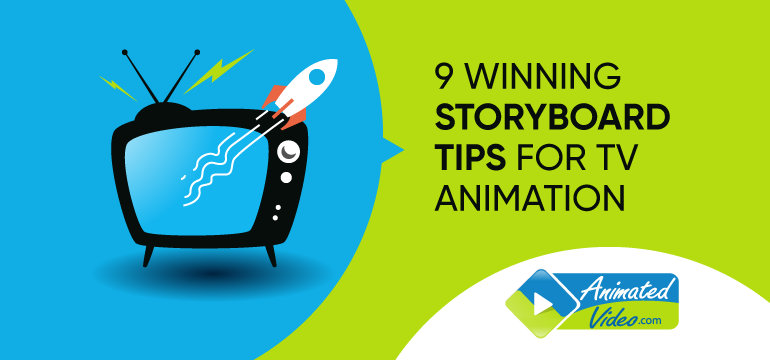Last Updated on April 13, 2022
The art of storyboarding is the initial method of creating a mesmerizing tale on TV animation for your audience. With creative storyboarding, you can present your message with clarity and structure. Thus, before shooting any kind of animated video you need to plan on boards and form stories and this is possible only through depicting your creativity in a paper. However to unleash this artistry you need to master the technique of storyboarding. We have scoured a few sites and finalized 9 winning storyboard tips for TV animation.
Amongst different types of production processes for TV, developing an animated television program requires hardworking and meticulous planning. In TV animation every single frame of an animated show should be hand drawn. This way the animator can connect single dots and make the most engaging animation. Hence comes the importance of storyboarding, which is the best technique that makes everything easy for the presenter to explain and make the audience understand the required information that you intend to deliver them.
Take a look below to get animation storyboard ideas and create one of the best storyboard examples. Did you know there are different types of storyboards? If not then just take a tour of the animation scripts and find out which one suites your style.
Tip#1: Character Poses are Vital in Deciding
Focus on creating simple and clear poses for each of your character, but each must be unique in style. There must be a balance in the poses of your characters. Too many poses on your characters would make it lose emphasis and similarly too few poses would make the character lost out on the screen. Hence, try to capture the feeling of each character and capture the emotionality. It’s ideal to change poses when the attitude of the cast turns and providing an opportunity to show about the character thinking and changing behavior.
Tip#2: Establish Continuity for Ultimate Effect
Continuity is one of the crucial elements of storyboarding. Every storyboard artist must maintain continuity to ensure the geography of the space and characters. Screen direction is an important fundamental aspect of continuity in filmmaking principle. To establish continuity, it’s required to create the characters moving from left to right or right to left. Every artist must try to maintain that direction of movement while the role is onscreen.
Tip#3: Every Frame Requires Special Attention
In a storyboard every drawing must complement each other and move the story ahead smoothly, This can be achieved only when an artist gives special attention to every frame and present a story into small fragments distributing in the keyframes. Finally, this refined creative can then be elaborated into a more complex narrative. Although, sometimes this becomes a challenge for the storyboarding artists, yet one must take care of it to present the best idea possible. You mustn’t draw too many similar images, remember that each frame counts.
Tip#4: Shuffling Makes Storyboard Panels Interesting
It’s apparent that while creating storyboards you will have a bunch of images and you need to emphasize on each of the photos to give meaning in the story. You even need to re-sequence them and discard as many pictures as possible. To induce sense in the story, every storyboard artist must move all until a coherent balance comes into being. Industry pros relate that such cuts and shuffling are possible when you present ideas with stick figures, then afterward replace everything with your character drawings once you know what you are done. To make your storyboard more creative, you need to work on gaps of any visual superfluities that reinforce the story.
Tip#5: Consistent Theme and Style is Imperative
As it’s known that storyboarding is the way to give an artistic perspective to an animation, hence to maintain the flow you need to preserve a consistent theme and style to provide a certain look and feel to the story. Indicate in your storyboard well the way you want to reflect on your TV animation. It’s vital to learn more about the style and method of maintaining such consistency. Creating theme and style are the fundamentals of storyboarding.
Tip#6: Know the Conventional Storyboard Format
As the modern-day storyboard artist, you must know the exact and traditional form of showing your storyboards. Industry pros state that 4×4 or 5×3 panels per page are the ideal formats. Ideally, if you include numerous panels on a page, it would make it easier for the animator to see how you want to relate one shot to another and how you want to cut between shots.
Tip#7: Don’t Forget to Focus On The Animation Layout
Animation layout is another vital focal point in TV animation. It’s the mechanism of demonstrating how an animation camera works. Remember that the illusion of a dimensional, moving camera focuses on the designing artwork that slides past the camera. So you need to create layers of art designed that synchronizes well. This approach would give an illusion of depth.
Tip#8: Understand the Camera Movements
While creating characters, their poses and narrating a story, it’s essential for every storyboard artist to understand camera shot and angle. Identify whether your characters portray the actual mood of the scene and whether they fit into the context. What kind of shot would fit in for example when it’s about close up you need to draw a character accordingly. In addition to that find out what type of camera move the filmmaker is going to use.
Tip#9: Time and Editing Matter The Most
Last, not the least, editing and maintaining the timing during the proceedings of each scene or shots are one of the fundamental elements of storyboarding. You need to focus on designing your story so that it works in sequence. Spend lots of time to extend, compress and reorder time to make your story suitable and impressive. Focus on creating variation in shot sizes and designs while transiting from one shot to another. As a storyboard artist, you must know that film has a language and you need to develop a story through your creativity that lets your audience ‘hear’ this language. Without proper editing, it’s not possible. Concentrate on each character movement within the scene, sequencing of shots and also time allocated to scenes, etc.
Your Turn
Storyboarding is creating the story outline before animation. You can’t present a compelling animated story without first drawing it. Every animation becomes a success when you narrate the desired story through effective planning. Hope the above tips serve the purpose and make you the next best storyboard artist in the industry.
At animated video.com we take of all your creativity woes. Whether you are suffering from a creative block or you are not well aware of the recent technical developments within the industry, we are here to solve all your problems instantly.




